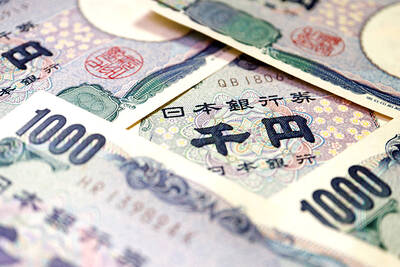Ant Group (螞蟻集團) plans to increase the valuation target for its initial public offering (IPO) to at least US$280 billion due to strong demand, charging ahead with the sale even as the administration of US President Donald Trump weighs restrictions on the Chinese fintech giant, people familiar with the matter said.
The Hangzhou-based company is lifting the target by at least 12 percent from a previous estimate of US$250 billion after initial discussions with investors, the people said, requesting not to be identified because the matter is private.
Ant aims to raise about US$35 billion in the sale, they said.
Despite the US headwinds, Jack Ma’s (馬雲) Ant is moving ahead with what could be the world’s largest IPO, with same-day listings in Hong Kong and Shanghai, the people said.
At US$280 billion, Ant would be bigger than Bank of America Corp and three times the size of Citigroup Inc, while its sale would top Saudi Aramco’s record US$29 billion raise.
The Hong Kong stock exchange has scheduled an Ant hearing for as soon as next week, pending an approval from the China Securities Regulatory Commission, a requirement for companies conducting dual listings in mainland China and Hong Kong, the people said. Ant and the Hong Kong bourse declined to comment in e-mailed statements.
The Hong Kong hearing before a 28-member panel of external professionals has been expected for weeks, but has yet to happen. If it is delayed much further, the IPO risks straddling the Nov. 3 US presidential election where some expect a surge in postal ballots to create prolonged uncertainty. The one-week gap in Hong Kong between the pricing of an IPO and the start of trading means that investors would be left exposed to an increase in volatility.
The Trump administration is exploring restrictions on Ant, as well as rival Tencent Holdings Ltd (騰訊), over concerns that their digital payment platforms threaten US national security.
Trump’s ban on Tencent’s WeChat in the US is facing pushback. A US magistrate judge this week said that she is unlikely to allow Washington to implement prohibitions on Wechat while the US government appeals her earlier ruling.
Ant said it is making progress in getting the required approvals for its IPO in Shanghai and Hong Kong, following reports that it has yet to receive a green light from the Chinese securities watchdog.
Ant has added Barclays PLC, ICBC International (工銀國際) and BOC International to its list of joint book runners for the Hong Kong sale, the people said.
That is in addition to China International Capital Corp (中金公司), Citigroup, JPMorgan Chase & Co, and Morgan Stanley acting as sponsors, and Credit Suisse Group AG acting as joint global coordinator for the Hong Kong leg.
Singapore’s sovereign fund GIC Pte is planning to invest more than US$1 billion in Ant’s Hong Kong and Shanghai IPO, the people said.
The listing is also drawing interest from investors like Temasek Holdings Pte and the China’s National Council for Social Security Fund, they said.

AI TALENT: No financial details were released about the deal, in which top Groq executives, including its CEO, would join Nvidia to help advance the technology Nvidia Corp has agreed to a licensing deal with artificial intelligence (AI) start-up Groq, furthering its investments in companies connected to the AI boom and gaining the right to add a new type of technology to its products. The world’s largest publicly traded company has paid for the right to use Groq’s technology and is to integrate its chip design into future products. Some of the start-up’s executives are leaving to join Nvidia to help with that effort, the companies said. Groq would continue as an independent company with a new chief executive, it said on Wednesday in a post on its Web

GROWING OWINGS: While Luxembourg and China swapped the top three spots, the US continued to be the largest exposure for Taiwan for the 41st consecutive quarter The US remained the largest debtor nation to Taiwan’s banking sector for the 41st consecutive quarter at the end of September, after local banks’ exposure to the US market rose more than 2 percent from three months earlier, the central bank said. Exposure to the US increased to US$198.896 billion, up US$4.026 billion, or 2.07 percent, from US$194.87 billion in the previous quarter, data released by the central bank showed on Friday. Of the increase, about US$1.4 billion came from banks’ investments in securitized products and interbank loans in the US, while another US$2.6 billion stemmed from trust assets, including mutual funds,

RESPONSE: The Japanese Ministry of Finance might have to intervene in the currency markets should the yen keep weakening toward the 160 level against the US dollar Japan’s chief currency official yesterday sent a warning on recent foreign exchange moves, after the yen weakened against the US dollar following Friday last week’s Bank of Japan (BOJ) decision. “We’re seeing one-directional, sudden moves especially after last week’s monetary policy meeting, so I’m deeply concerned,” Japanese Vice Finance Minister for International Affairs Atsushi Mimura told reporters. “We’d like to take appropriate responses against excessive moves.” The central bank on Friday raised its benchmark interest rate to the highest in 30 years, but Bank of Japan Governor Kazuo Ueda chose to keep his options open rather than bolster the yen,

Even as the US is embarked on a bitter rivalry with China over the deployment of artificial intelligence (AI), Chinese technology is quietly making inroads into the US market. Despite considerable geopolitical tensions, Chinese open-source AI models are winning over a growing number of programmers and companies in the US. These are different from the closed generative AI models that have become household names — ChatGPT-maker OpenAI or Google’s Gemini — whose inner workings are fiercely protected. In contrast, “open” models offered by many Chinese rivals, from Alibaba (阿里巴巴) to DeepSeek (深度求索), allow programmers to customize parts of the software to suit their